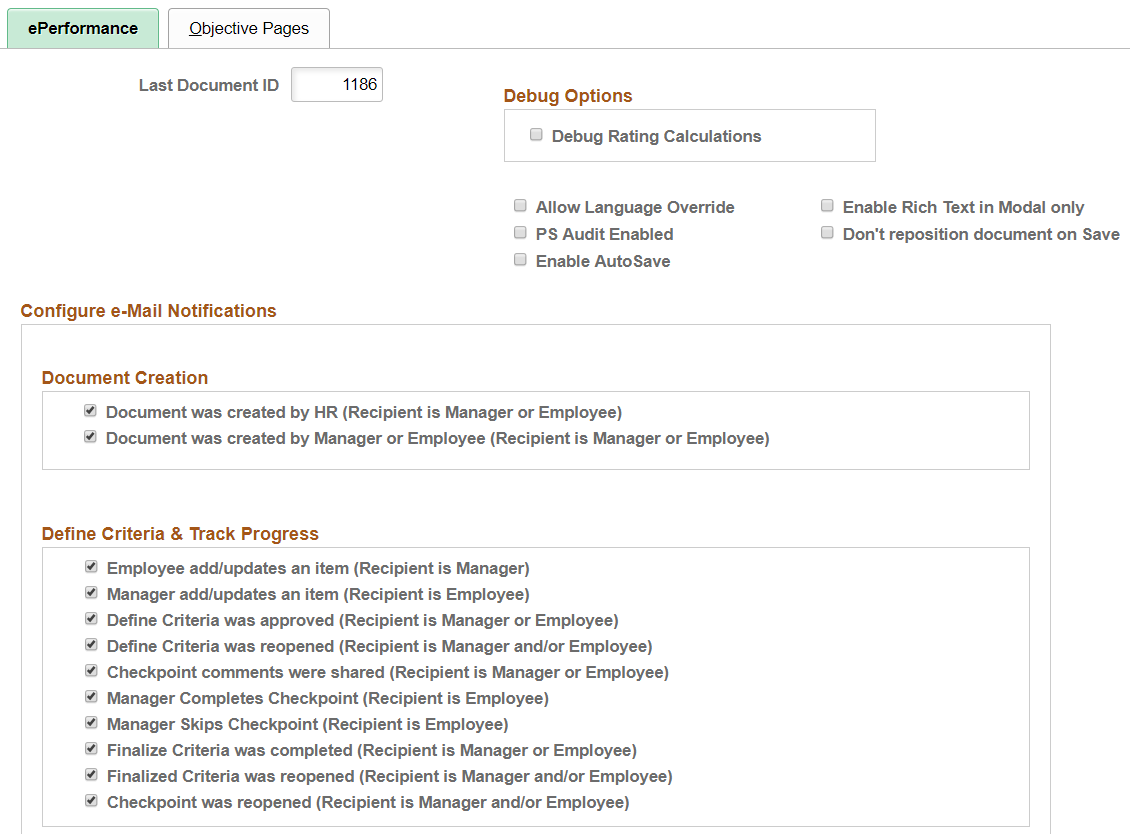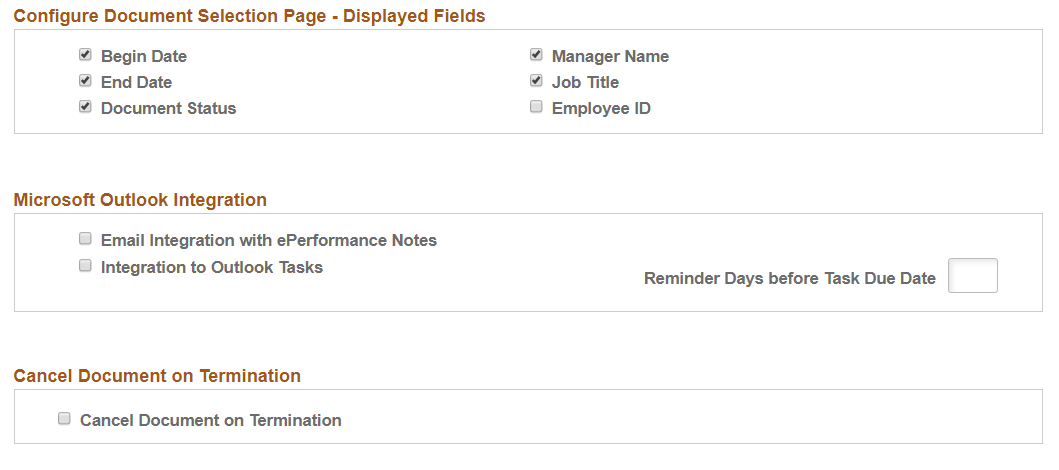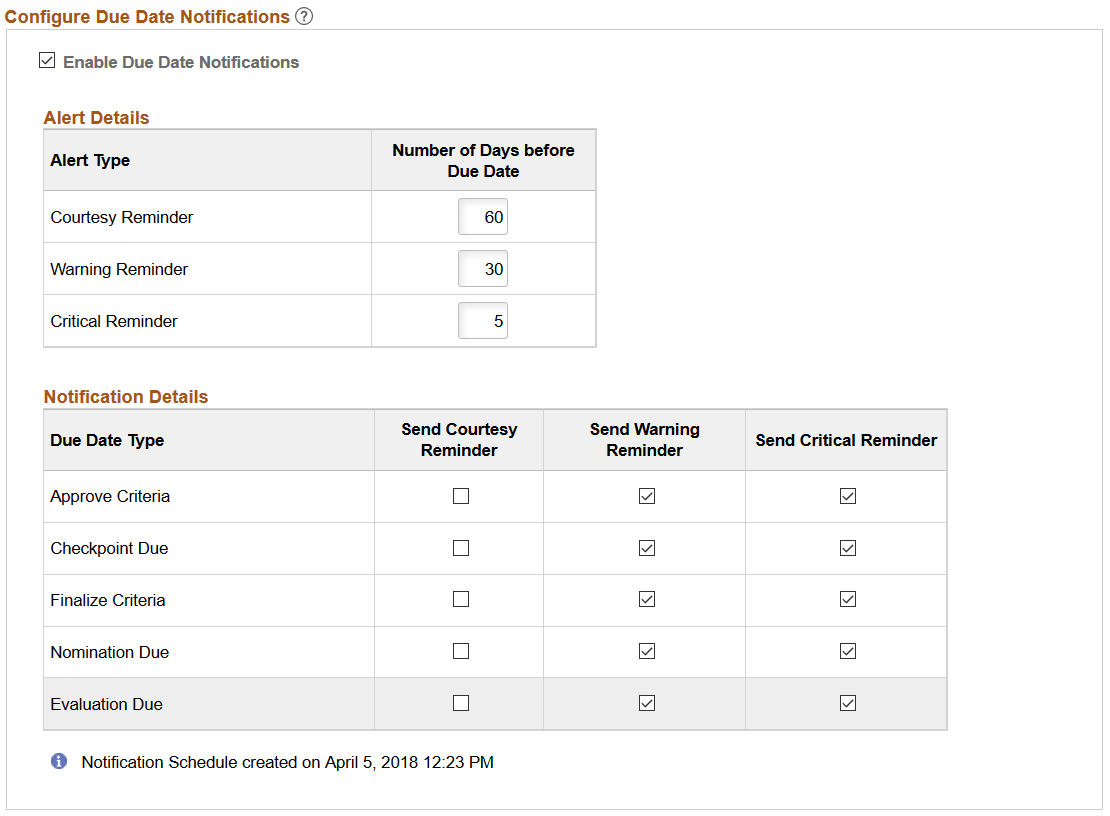Defining System Settings
To define system settings for ePerformance, use the ePerformance (EP_INSTALLATION) component.
This topic provides an overview of system settings in ePerformance and discusses how to define system settings.
|
Page Name |
Definition Name |
Usage |
|---|---|---|
|
EP_INSTALLATION |
Define system settings. |
System settings control certain processing options. You can modify these delivered system settings to meet your business needs:
Whether users can generate documents in languages other than the base language.
Debug settings.
Starting number for document ID generation.
Fields that appear on the page from which users select documents.
The email notifications that the system generates.
Use the ePerformance page (EP_INSTALLATION) to define system settings.
Navigation
Image: ePerformance page (1 of 3)
This example illustrates the fields and controls on the ePerformance page (1 of 3).

Image: ePerformance page (2 of 3)
This example illustrates the fields and controls on the ePerformance page (2 of 3).

Image: ePerformance page (3 of 3)
This example illustrates the fields and controls on the ePerformance page (3 of 3).

Image: ePerformance page (4 of 4)
This example illustrates the fields and controls on the ePerformance page (4 of 4).

|
Field or Control |
Definition |
|---|---|
| Last Document ID |
Enter the number from which the system begins generating document IDs. The system automatically generates the document ID by adding 1 to the Last Document ID. Warning! Entering a value that is lower than the value that appears can cause unpredictable results. |
| Debug Rating Calculations |
Select this check box to have the system generate a debug/trace log every time it calculates the ratings in an evaluation. HR ePerformance administrators use the Debug/Trace Results page to review the results of each calculation performed for an evaluation. This helps track down any unexpected results when you build templates and test the configuration. Warning! Producing the debug/trace log can have a significant impact on system performance. Select this option only if you are testing the ePerformance configuration or debugging a suspected calculation problem. |
| Allow Language Override |
Select this check box to enable document generation in a language other than the system base language. If this check box is deselected, the system generates all documents in the system base language. The base language is defined using the Manage Installed Languages page in PeopleTools. |
| PS Audit Enabled |
Select this check box to enable Detailed Item History audits. In addition to selecting this check box, you must also use Application Designer to turn on the audits that you want to use. Select the Audit fields in the Record Field Properties dialog box for the EP_APPR_B_ITEM object. When this audit is enabled, the system displays the Modification History link on document pages used for establishing criteria data. Users can click this link to access the Modification History page (EP_ITEM_MOD_HISTRY), which displays before and after values by field name. The Detailed Item History audit is delivered turned off. This audit is controlled by a database trigger. See the topic on Setting Record Field Use Properties in the PeopleTools: Application Designer Developer's Guide. |
| Enable AutoSave |
Select this check box to enable the AutoSave feature in ePerformance. Note: Be sure to disable the popup blocker feature in your browser for the AutoSave feature to work properly. For security purposes, you can set up in PeopleTools the ability to display inactivity warnings to users, and time out their browser sessions if they don’t respond to the warning messages within a specific timeframe. When the AutoSave feature is selected, the system automatically saves documents before browser sessions are timed out, preventing users’ unsaved data from being lost due to inactivity. When enabled, the AutoSave feature applies to all performance and development document pages (including modal pages) in the EP_APPR_BASE and EP_APPR_MAIN components, which are used for defining evaluation criteria, tracking mid-period progress, and entering self, manager, as well as peer (or other role-based) evaluations. This feature is not supported in performance notes. |
| Enable Rich Text in Modal only |
Select this check box for users to enter evaluation comments in a modal window. By default, this feature is disabled. Enable this option if you experience performance issues when entering comments in rich-text fields on main document pages. When enabled, comments fields are displayed as read-only on documents. To enter comments, users click either the Edit Comments link or Writing Tools link to open a modal page, where they compose comments in plain or rich text. When disabled, users enter comments (plain or rich text) in comments fields directly. |
| Don’t reposition document on Save |
Select this check box to allow the cursor to remain
in the same position when documents are saved. By default, this option
is disabled.
Clear this check box for the cursor to reposition to the top of the page when documents are saved. |
Configure e-Mail Notifications
Select the check box next to each event type for which you want the system to automatically generate and send notifications. Event types are grouped into these categories for better organization: Document Creation, Define Criteria & Track Progress, Nominations, Evaluations, and Administrative Task.
Several event types have the notification recipient set as manager or employee. What it means is that the recipient will be determined by the role performing the event. For example, if the manager approves the evaluation criteria document and the Evaluation Criteria is Approved event type is enabled, the system sends a notification to the employee of the document.
Configure Document Selection Page - Displayed Fields
Select the fields that you want to appear in the document list from which self service users select documents.
See Accessing Documents.
Microsoft Outlook Integration
|
Field or Control |
Definition |
|---|---|
| Email Integration with ePerformance Notes |
Select to enable the functionality to allow users to insert email content from Microsoft Outlook directly into performance notes |
| Integration to Outlook Tasks |
Select to enable the functionality to create tasks in Microsoft Outlook for users to keep track of due dates in performance and development documents. |
| Reminder Days before Task Due Date |
Enter the number of days before the due date that a task reminder should be set. Enter this information if the Integration to Outlook Tasks field is selected. |
Cancel Document on Termination
|
Field or Control |
Definition |
|---|---|
| Cancel Document on Termination |
Select to enable the functionality to automatically cancel in-progress documents for employees who have been terminated in the HR system. By default, this option is not selected and subsequent fields are not visible. |
| All Document Types |
Select for the process to cancel current documents of all document types for terminated employees. |
| Selected Document Types and Document Types |
Select for the process to cancel current documents that are associated with specific document types. When selected, add the document types in the Document Types section. |
Configure Due Date Notifications
|
Field or Control |
Definition |
|---|---|
| Enable Due Date Notifications |
Click to activate the Due Date Notifications feature
that sends automatic email reminders to users when their documents
are due for updates.
When this feature is enabled, be sure to specify the scheduling options in the Alert Details and Notification Details sections accordingly. |
| Alert Type |
Displays the types of reminders that the Due Date Notifications feature supports. Values are Courtesy Reminder, Warning Reminder, and Critical Reminder. |
| Number of Days before Due Date |
Enter the number of days before the due date that email notifications for the corresponding alert type should be sent. The value for courtesy reminder must be greater than the one for warning reminder, which must be greater than the one for critical reminder. For example, the courtesy reminder option is enabled for the Define Criteria Approval due date type, and reminders are set to be sent 60 days before the due date. If the Define Criteria step due date of a document is on April 1, the systems sends a courtesy reminder for it on February 1 of the same year. |
| Due Date Type |
Displays the steps in an evaluation cycle for which due date notifications can be sent. |
| Send Courtesy Reminder, Send Warning Reminder, and Send Critical Reminder |
Select the check boxes for the system to send a combination of courtesy reminders, warning reminders, and critical reminders for the corresponding evaluation step in documents, based on the specified alert type values. |
| Notification Schedule created on |
Displays the date and time that the initialization process was run. The initialization process extracts the due date information of all Evaluation In Progress evaluation documents, and loads it into the schedule table (EP_NOTIFY_TBL) to be used to generate due date notifications for steps that are not completed or canceled. In addition to specifying the alert and notification details, you also need to run the initialization process as part of the setup for the Due Date Notifications feature, if there are evaluation documents in the system that are still in progress. The initialization process is not necessary, if there are no in-progress documents in the system (for example, at the end of an evaluation cycle). See Also Setting Up Due Date Notifications |